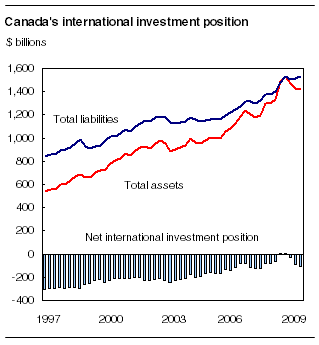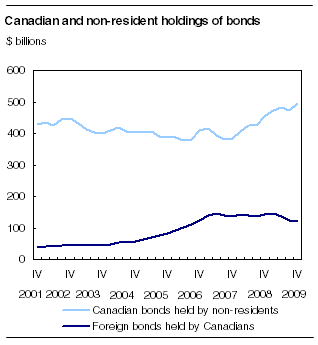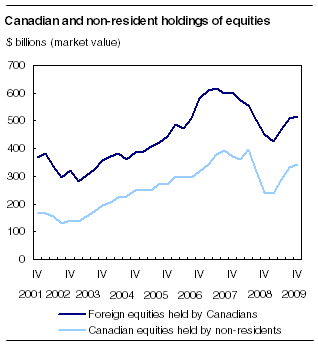Common menu bar links
Canada's international investment position
Archived Content
Information identified as archived is provided for reference, research or recordkeeping purposes. It is not subject to the Government of Canada Web Standards and has not been altered or updated since it was archived. Please "contact us" to request a format other than those available.
Related subjects
Canada's net foreign debt increased by $23.4 billion to $109.5 billion at the end of the fourth quarter of 2009, reflecting an ongoing current account deficit as well as the revaluation effect of the appreciation of the Canadian dollar.
Canada's international assets were $1,420.4 billion at the end of the fourth quarter of 2009, down 0.4% from the third quarter, largely reflecting the downward revaluation of these Canadian foreign currency-denominated holdings. Meanwhile, international liabilities were up 1.2% to $1,529.8 billion, mainly the result of a continued reliance on investments from abroad to finance the current account deficit. As a result of these changes, Canada's net foreign debt position expanded to $109.5 billion at the end of the fourth quarter of 2009.

Exchange rate fluctuations moderated in the fourth quarter, but continued to have an impact. The revaluation effect on Canada's international assets and liabilities from the appreciation of the Canadian dollar, along with other adjustments, accounted for just under 50% of the $23.4 billion increase in the net foreign debt position in the fourth quarter. Canadian borrowing from abroad accounted for the balance.
Canadian dollar appreciation lowers international assets more than it does liabilities
The Canadian dollar continued its appreciation against all major currencies in the fourth quarter of 2009, gaining 1.9% against the US dollar, 5.7% against the Japanese Yen, 4.1% against the Euro, and 0.7% against the British Pound.
As most of Canada's international assets are denominated in foreign currencies and less than half of Canada's liabilities are in foreign currencies, these gains had a larger impact on assets (-$26.1 billion) than on liabilities (-$12.1 billion). Although exchange rate revaluations had a relatively small effect in the fourth quarter, their total impact for 2009 resulted in a reduction of $156.3 billion in international assets and a decrease of $78.2 billion in international liabilities.
Note to readers
The international investment position presents the value and composition of Canada's foreign assets and liabilities to the rest of the world. Canada's net international investment position is the difference between these foreign assets and liabilities. The excess of international liabilities over assets can be referred to as Canada's net foreign debt. The excess of international assets over liabilities can be referred to as Canada's net foreign assets. The valuation of the assets and liabilities in the international investment position are measured at book value, unless otherwise stated. Book value represents the value of assets and liabilities recorded in the books of the enterprise in which the investment is made.
Currency valuation
The value of assets and liabilities denominated in foreign currency are converted to Canadian dollars at the end of each period for which a balance sheet is calculated. When the Canadian dollar is appreciating in value, the restatement of the value of these assets and liabilities in Canadian dollars lowers the recorded value. The opposite is true when the dollar is depreciating.
Canadian direct investment assets dampened by currency appreciation
Outward direct investment activity remained strong in the fourth quarter with transactions of $14.0 billion. The revaluation of direct investment assets largely offset this activity, resulting in a net increase of $1.0 billion, the first in Canadian direct investment assets since the first quarter of 2009.
On the liability side, transactions gave rise to a $4.2 billion increase in foreign direct investment in Canada. The overall effect of these changes corresponded to a small reduction in the net foreign direct investment asset position, which totalled $85.4 billion at the end of the fourth quarter of 2009.
For the year, direct investment assets were down $34.2 billion, as the Canadian dollar appreciated, while foreign direct investment in Canada rose $12.8 billion. This led to a decline of $47.0 billion in the net direct investment position in 2009.
Foreign holdings of Canadian bonds up strongly
Non-resident investors added a further $27.7 billion of Canadian securities to their portfolios in the fourth quarter, both government and corporate bonds. However, the appreciation of the Canadian dollar decreased the value of foreign investors' bond holdings by $6.9 billion. In addition, the composition of Canadian bond liabilities held by non-residents was also affected in 2009, with both average term to maturities and average interest rates down.
For their part, Canadian investors removed $1.3 billion of foreign securities from their portfolios in the fourth quarter, while currency revaluations lowered the value of these holdings by another $9.1 billion. As a result of this decline and the increase in Canadian portfolio securities held by non-residents, the net foreign liability position on securities widened a further $30.3 billion.

These changes were more significant for the year as a whole. Canadian holdings of foreign securities were down $44.0 billion, largely as a result of the impact of the exchange rate. However, foreign holdings of Canadian securities were up $55.0 billion, despite the $46.0 billion reduction attributable to the effect of the exchange rate.
Currency revaluation effect moderates gains in foreign equity markets
Canada's overall international investment position can also be calculated with assets and liabilities of tradable securities valued at market prices. By this measure, net foreign debt reached $68.6 billion at the end of the fourth quarter of 2009, registering a smaller decrease than the one measured at book value, largely on the strength of stock markets.
Canadian assets were up 0.7% to $1,721.8 billion, while liabilities rose 1.8% to $1,790.5 billion. Although equity markets rallied in general during the quarter, foreign equity markets fared better than Canadian equity markets, giving a boost to Canadian holdings of foreign equity. However, these large gains in Canadian holdings of foreign equity assets were dampened by losses from the revaluation effect of the appreciation of the Canadian dollar during the quarter (-$10.1 billion).

For 2009, the value of foreign equities held by Canadians rose $66.0 billion on buoyant stock markets abroad. These gains would have been larger had it not been for the appreciation of the Canadian dollar, which reduced the value of these holdings by $58.4 billion.
Available on CANSIM: tables 376-0055 to 376-0057 and 376-0059.
Definitions, data sources and methods: survey number 1537.
The fourth quarter 2009 issue of Canada's International Investment Position (67-202-X, free) will be available soon.
For more information, contact Client Services (613-951-1855; infobalance@statcan.gc.ca). To enquire about the methods, concepts or data quality of this release, contact Komal Bobal (613-951-6645), Balance of Payments Division.
Table 1
| Fourth quarter 2005 | Fourth quarter 2006 | Fourth quarter 2007 | Fourth quarter 2008 | First quarter 2009 | Second quarter 2009 | Third quarter 2009 | Fourth quarter 2009 | |
|---|---|---|---|---|---|---|---|---|
| $ billions | ||||||||
| Assets | ||||||||
| Canadian direct investment abroad | 452.2 | 524.7 | 515.4 | 637.3 | 654.8 | 626.9 | 602.0 | 603.1 |
| Portfolio investment abroad | ||||||||
| Foreign bonds | 82.3 | 124.0 | 135.4 | 141.9 | 144.8 | 136.8 | 123.0 | 120.9 |
| Foreign bonds at market value | 88.8 | 133.7 | 153.3 | 176.0 | 176.5 | 172.4 | 161.8 | 158.6 |
| Foreign stocks | 196.8 | 227.3 | 226.6 | 278.9 | 292.7 | 280.4 | 263.2 | 254.8 |
| Foreign stocks at market value | 445.0 | 582.2 | 603.8 | 451.6 | 424.3 | 469.3 | 507.3 | 517.5 |
| Foreign money market | 13.1 | 20.0 | 7.5 | 3.5 | 5.8 | 5.0 | 4.4 | 4.6 |
| Foreign money market at market value | 13.1 | 20.1 | 7.5 | 3.5 | 5.8 | 5.1 | 4.4 | 4.6 |
| Other investments | ||||||||
| Loans | 45.9 | 72.9 | 77.3 | 94.5 | 97.3 | 98.8 | 100.3 | 103.5 |
| Deposits | 120.8 | 132.2 | 157.9 | 225.2 | 228.6 | 216.3 | 215.7 | 220.9 |
| Official international reserves | 38.0 | 41.0 | 40.6 | 51.4 | 53.1 | 50.8 | 60.7 | 56.0 |
| Official international reserves at market value | 38.4 | 40.9 | 40.7 | 53.4 | 54.9 | 51.9 | 62.3 | 57.1 |
| Other assets | 47.2 | 45.9 | 37.9 | 53.5 | 57.2 | 55.1 | 56.4 | 56.6 |
| Total assets | ||||||||
| At book value | 996.4 | 1,188.1 | 1,198.6 | 1,486.2 | 1,534.2 | 1,470.0 | 1,425.8 | 1,420.4 |
| With portfolio investment at market value | 1,251.4 | 1,552.7 | 1,593.9 | 1,694.9 | 1,699.3 | 1,695.7 | 1,710.2 | 1,721.8 |
| Liabilities | ||||||||
| Foreign direct investment in Canada | 397.8 | 438.6 | 491.3 | 504.9 | 503.9 | 501.8 | 513.4 | 517.6 |
| Portfolio investment | ||||||||
| Canadian bonds | 387.9 | 409.2 | 384.7 | 454.1 | 472.7 | 483.8 | 472.4 | 494.5 |
| Canadian bonds at market value | 414.5 | 431.5 | 399.5 | 467.9 | 472.2 | 496.3 | 499.4 | 523.4 |
| Canadian stocks | 93.5 | 99.0 | 95.8 | 96.0 | 97.7 | 101.5 | 111.5 | 112.6 |
| Canadian stocks at market value | 271.4 | 318.7 | 371.0 | 241.7 | 237.1 | 288.6 | 332.0 | 344.3 |
| Canadian money market | 20.8 | 24.5 | 22.0 | 34.9 | 44.8 | 44.4 | 36.1 | 32.9 |
| Canadian money market at market value | 20.9 | 24.7 | 22.2 | 35.0 | 45.0 | 44.6 | 36.2 | 32.9 |
| Other investment | ||||||||
| Loans | 38.2 | 53.0 | 61.2 | 64.6 | 71.7 | 61.3 | 59.7 | 57.5 |
| Deposits | 201.0 | 226.8 | 243.5 | 301.2 | 313.7 | 286.3 | 286.2 | 282.4 |
| Other liabilities | 22.0 | 21.6 | 26.0 | 23.9 | 24.1 | 23.5 | 32.5 | 32.4 |
| Total liabilities | ||||||||
| At book value | 1,161.3 | 1,272.7 | 1,324.4 | 1,479.4 | 1,528.6 | 1,502.7 | 1,511.8 | 1,529.8 |
| With portfolio investment at market value | 1,365.8 | 1,514.9 | 1,614.7 | 1,639.1 | 1,667.6 | 1,702.5 | 1,759.4 | 1,790.5 |
| Net international investment position | ||||||||
| At book value | -164.9 | -84.6 | -125.7 | 6.7 | 5.6 | -32.7 | -86.0 | -109.5 |
| With portfolio investment at market value | -114.4 | 37.7 | -20.7 | 55.9 | 31.7 | -6.8 | -49.2 | -68.6 |

